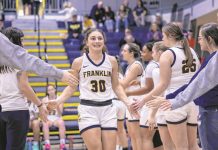To a young Danny Brown, it seemed like the kind folks from the school district were building his own personal playground.
It was the late 1960s and Brown, a seventh-grader, would ride his bike down the street in North Vernon to watch the construction of the new Jennings County High School, and especially the gymnasium.
Eventually, watching wasn’t enough. He started trying the doors to see if they were locked.
“I would sneak in there and shoot,” said Brown, who never ended up in the clink for his transgressions. Instead, he honed a skill that eventually landed Jennings County an awesome distinction.
The new school opened the year before Brown’s freshman season, and two years later, during the glorious season of 1971-72, Brown and his Panther teammates set an Indiana high school boys basketball record of averaging 92.9 points per game.
That record has stood the test of time, although Evansville Reitz is making a run at the record this year, at 92.2 points with Saturday’s semistate game against Richmond at Seymour and a possible state title shot remaining.
Brown scored 27.5 points per game during that 1971-72 season and now it’s evident that his career has stood the test of time as well. On Wednesday at the Primo Banquet Hall in Indianapolis, Brown will be inducted into the Indiana Basketball Hall of Fame.
“We played basketball all day, every day,” said Billy Harmon, Brown’s childhood friend and teammate who was inducted into the Indiana Basketball Hall of Fame a year ago. “That’s how we got good. We weren’t just blessed with being good; we had to work at it.”
Harmon admitted that having a new gym being constructed right down the street was too much to resist.
“We went into (the gym under construction) a few times,” he said with a laugh. “Danny could shoot that ball.”
On to Louisville
Brown shot so well he set a Jennings County High School career scoring record with 1,960 points and he eventually went with Harmon to the University of Louisville where they helped the team to three NCAA Tournament appearances and the Final Four in the 1974-75 season.
“His range was as a 3-point shooter,” said former Louisville assistant Bill Olsen, who recruited Brown and Harmon for head coach Denny Crum. “But they didn’t have a 3-point shot then. He would have been our best 3-point shooter.
“At Louisville, we were loaded with great players, so Danny never got a chance to expose his skills and his ability. We had two first-round draft picks in the backcourt in Junior Bridgeman (NBA Los Angeles Lakers, 1975) and Allen Murphy (ABA Kentucky Colonels, 1975). Danny was an outstanding player in his own right and, while he didn’t get to play as much as he would have somewhere else, he was very important to our team.”
Olsen remembered the buzz Jennings County’s boys basketball team created during Brown’s senior season.
“You have to understand that I grew up in Vincennes at the time Milan won the state championship (1954),” Olsen said. “Indiana basketball was special, as it was in the 1970s. I remember Coach (Bill) Springer and being impressed with how well-coached that Jennings County team was.”
Olsen also was impressed with Brown, who was being recruited by more than 100 universities, including Indiana with Bobby Knight and Kentucky with Joe B. Hall.
“What attracted me most was how he could handle the ball, pass and shoot as well as any player that we were recruiting,” said Olsen, who eventually became Louisville’s athletics director. “He was a clone of Pete Maravich. Danny had that kind of skill. He was a compete player.”
Although some people might have thought Brown was trying to be flashy by passing the ball behind his back and through his legs during games, Olsen had a different view.
“When you can do all those things that Maravich could do, that’s hard to defend,” Olsen said. “A lot of times, those passes (behind the back or through the legs) are the best passes you could make.”
Maravich was Brown’s idol. “By the time I was in eighth grade, I could do a lot of the things with the ball that Maravich did,” Brown said. “But I would play basketball eight to 10 hours a day.”
Much of that time was spent with Harmon, who lived about a mile away.
In the beginning
Brown grew up as the youngest of four children of Curt and Evelyn Brown in North Vernon. His dad was director of the planning commission for the county and he ran the local parks. Evelyn Brown was a designer for Regal Rugs.
His dad, one of the area’s top pitchers in fast-pitch softball, wasn’t a basketball player but knew athletics enough to give his son some good advice.
“My dad said if you want to be a good ballplayer, you’ve got to learn to go to your left,” Danny Brown said. “He wanted me to use my left hand. I took that to heart.”
Eventually, he was turned loose in high school by Jennings County head coach Don Schroeder, who coached Brown his freshman through junior seasons.
Schroeder had been working with Brown and Harmon in clinics since they were fourth-graders, and he was well aware what they could do. He estimated that Brown would have averaged 35- to 40-points through his high school career if there had been a 3-point shot. “He was probably one of the best shooters, if not the best, I’ve ever had,” Schroeder said.
In turn, Brown loved playing for Schroeder, who led Brown’s junior team to the scoring record.
“We averaged 101 points per game at home that season,” Brown said. “We scored 272 points in two games on a weekend against North Dearborn (142-38) and Clarksville (130-68).
“Along with Billy, we had Bobby Woods, who was our 6-foot-6 center. Either Billy or Bobby would get a rebound and away we went. I averaged 27.5, Billy averaged 21.6 and Bobby averaged 20.8. That was unheard of.”
Brown’s junior season at Jennings County produced his best basketball memory.
“We played for the Eastern Indiana Athletic Conference championship at Lawrenceburg. We were down five points with 19 seconds to go and they had the ball. There was a snowstorm that night, so people were leaving to get home and because ‘This game was over.’
“They had the ball, but Billy tipped the inbounds pass, and I scored on a layup. Then we pressed and tipped another ball, and I scored on a bank shot.
“Then they tried to throw it in again and Billy tipped it again. I wound up getting the ball and I got fouled in the act of shooting. With four seconds left, I hit them both. The funny thing was that they threw up a half-court shot and it almost went in, but it rattled around and out. We won 75-74.”
Cheering section
Teresa Brown, who has been married to Danny for 39 years, was a cheerleader at the time.
“The Final Four (with Louisville) was good, but I think high school was the most exciting time for me,” she said. “Probably the Lawrenceburg game was the top moment. People adamantly refused to believe me that they had won that game.”
Springer took over Jennings County for Brown’s senior year, and the team kept scoring big and winning.
“He was a stickler at the defensive end,” Brown said of Springer. “But he didn’t come in and change our offense from what we had the year before.”
Brown said Springer used a Bob Knight-style of defense that would “deny the pass.”
“I learned defense from him more than anything,” Brown said. “First thing on Monday, we would not roll out the ball. We would just get on the line and run. We would get after conditioning and run his defense for an hour before we ever touched a ball. That would get our attention.”
While Jennings County won the sectional crown Brown’s junior season, the Panthers finished second his other three years of high school, losing to Seymour each time.
Brown remembers the fan reaction to his junior season even more than the basketball.
“The fans were special,” he said. “Before we won the sectional in 1972, I looked out the window and counted the fan buses as we were getting ready to leave the school. I counted 22 buses heading to Seymour.”
It was on to Louisville after his banner high school career.
“Those first two years, we both were in the rotation, especially on that ’75 team,” Harmon said. “Denny (Crum) will still tell people that was the best 12-player team he ever had.”
Although Brown didn’t play a starring role at Louisville, he enjoyed his experience.
“At Louisville, a lot of the guys were Indiana players that we had played against in high school,” Brown said. “Those players are still our friends. We loved each other and we had so much respect for Coach Crum and what he has done.”
Life was a bit different, though.
“We were a pretty simple family,” Brown said of his life growing up. “I never had pasta until I got to Louisville.”
He also fed on the excitement of big-time college basketball. The Final Four in 1975 was in San Diego and he remembers his excitement at seeing celebrities walking around such as Wilt Chamberlain, who was a coach for the San Diego Conquistadors (of the ABA) the year before, along with announcers Curt Gowdy, Dick Enberg and Billy Packer.
Brown continued to play a supporting role his final two seasons in Louisville, and he soaked up coaching knowledge from Crum in the meantime.
Aspiring coach
“I always said that if I ever coached in Indiana, I would use Coach Crum and Coach (John) Wooden’s offense,” Brown said. “I still use it, the high-post offense. It uses triangle rebounding, spacing and balanced scoring.”
He learned other things from Crum as well. “Coach Crum never cursed,” Brown said. “He was more of a teacher than anything. ‘Gosh darn’ was the most he ever said. I try to get through a season now without saying a curse word.”
After his career as a Cardinal, Brown spent 10 years before he joined the coaching ranks. In 1987, he became the junior varsity boys coach at Jennings County.
“The maddest that Danny ever got at me was during a JV game,” Harmon said. “I was helping him coach and we were way ahead late in a game. I said ‘Let’s clear the bench’ and he eventually did. We almost got beat. He was so angry. I told him, ‘I will never tell you to take anyone out again.’”
Brown spent the 1991-92 and 1992-93 seasons working as a volunteer coach at Louisville but eventually grew tired of the travel from North Vernon. In 1996, he took the job as Jennings County girls basketball coach. He has since spent 16 years coaching girls varsity basketball (He took three years off after being part of a teacher layoff at Greensburg High School).
Although Brown said he feels his induction into the Indiana Basketball Hall of Fame was due mostly to his time as a player, he has compiled a 246-119 coaching record with two Final Four appearances.
Brown went 58-38 at Jennings County and followed with an 18-4 record at Greensburg in the 1999-2000 season. He has posted a 188-91 record at Columbus East, including four sectional titles, the runner-up state finish in 2006-07 and another trip to the Final Four the following season.
“He deserves the Hall of Fame,” said Sara Riedeman, who played for Brown in Greensburg and graduated from there in 2001. “He was a good player, and he has been a big influence on my life.”
Riedeman is now an assistant women’s basketball coach at Indiana State.
“Danny is someone I think about when I coach myself,” she said. “Just his ability to give his players confidence, how he always believes in his team.
“He was intense, competitive. He loved to win games and he meshed with our team so well. He was somebody you could count on. And I was a shooter, so that’s why I think I got along with him so well. He taught me to just want the ball and be confident in it. There is such a stress on playing team ball, but he made sure I was always wanting the ball and shooting it.”
Inspiring others
Jordan Ogle, a 2009 Columbus East graduate, played on Brown’s Final Four teams at Columbus East and now works with him as an assistant coach.
“Obviously, I had a chance to do something that not a lot of people did (go to the Final Four),” Ogle said. “He was the reason for most of it. He was the first coach to introduce me to the run-and-gun offense.”
Ogle said Brown tends to be laid back and quiet most of the time.
“It really depended what was going on,” she said. “He would scream if he needed to. Most of the time, he was a quiet coach, unless we did something that was off the charts. Then it was a little different.
“Now I’ve coached with him two years and I can see he does a lot more than what I saw as a player. He does a lot of behind-the-scenes stuff and he is a lot more in-depth than what I saw. He knows what he is talking about, and if you buy into it you will play well.”
Most of Brown’s current players don’t understand that he was a high school superstar.
“When I was playing, we didn’t know,” Ogle said. “Then one day we were playing a conference game at Jennings County and we saw his stats and his photos. We were looking around going ‘Oh my goodness.’ And he had those short shorts on. I think we laughed about that more than anything.”
Willie Humes, a 1967 Madison High graduate who averaged 31.5 points per game during his college career at Idaho State, is an assistant with Brown at Columbus East, his second tour of duty with him.
“We have had a great relationship, and it has been fun,” Humes said. “I think we have hit it off because he scored, and I scored. We like to go up and down the court. When you get to know him, he is a great person with a great personality.”
Brown said the person he has become comes in large part to his wife, Teresa. “She is the most influential person in my life,” he said. “She keeps me walking the straight and narrow … she always has.”
“I like to say that basketball is the ‘other woman’ in this relationship,” Teresa Brown said. “I have used that a lot of times. A lot of basketball coaches’ wives could relate. But I envy his passion because I am a jack-of-all-trades and a master of none.
“I thought he would be a great coach because he is such an X’s and O’s man. I think he is a little more mellow now, maybe a little less competitive. He has learned through time that the game isn’t everything, not the end all, be all. I do think he still has fun with the game, and his players have fun playing.”
Harmon sees his friend as much the same, even though the years have passed.
“He is quiet, very focused, very regimented,” Harmon said.
“He always was very superstitious. On game day, he has to do the same things. He had a towel that had to be folded the same way.”
It is hard for Harmon to think so many years have passed since they played at Jennings County? “I don’t want to believe it,” Harmon said. “But when I got up this morning, it was easier to believe.”
Those days at Jennings County might be long ago, but the memories burn brightly for Brown, who loves those times he spent practicing and playing basketball with Harmon.
“Me and Billy were best of friends,” Brown said. “I remember our senior year and there was this furniture store in town. It had this sign that said, “Brown and Harmon, Mighty Charmin.’
“It was Brown and Harmon, Harmon and Brown. Here we are from a small town in Indiana, and now we are in the Hall of Fame.”
[sc:pullout-title pullout-title=”At a glance” ][sc:pullout-text-begin]
WHO: Danny Brown
WHAT: Indiana Basketball Hall of Fame induction
WHEN: 5 p.m., Wednesday
WHERE: Primo Banquet Hall, 2615 National Ave., Indianapolis
BROWN’S FAMILY: Wife Teresa (39 years); children, Sarah Brown (works for Cummins in Houston), Becky Brown (photographer in Chicago), Dan Brown (attends IU medical school in Muncie)
[sc:pullout-text-end]




